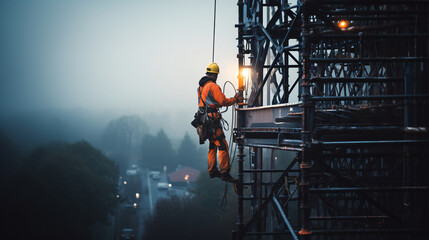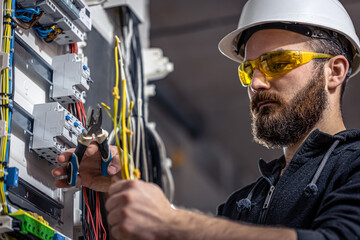Electrical safety is not just a buzzword; it's a critical consideration in various professions and everyday life. From the construction site to the comforts of our homes, electricity powers our modern world, but it also brings significant risks. In this comprehensive guide, we'll explore the inherent dangers of working with electricity and the invaluable role played by Electrical Personal Protective Equipment (PPE) in mitigating these risks. Whether you're an electrician, a safety professional, or someone who loves to take on DIY challenges, this post will equip you with a deeper insight into safeguarding against electrical hazards.

Understanding Electrical Hazards
Electricity, while essential, poses several serious threats. Each year, electrocutions are some of the leading causes of workplace fatalities. But why is it so deadly? Understanding these risks is the first step in preventing accidents.
Electric Shock Risks
Electric shock occurs when the body completes a circuit and the current passes through it. Even a seemingly minor shock can lead to severe injuries or death. The risks are compounded in wet or high-conductivity environments.
Arc Flash and Arc Blast Dangers
An arc flash is an electrical explosion due to a fault condition or through a test. It can produce very high-temperature flames, intense light, pressure waves, and shrapnel. The immense energy released during an arc flash event results in an arc blast, a supersonic shockwave that can cause severe injury. Protection from these phenomena is non-negotiable in environments prone to electrical anomalies.
Electrical Fires
Beyond direct human exposure, electricity can cause fires due to overloading, short circuits, and faulty equipment. These fires pose unique challenges and dangers for firefighting and can be exacerbated by the presence of flammable materials.
It's clear that even working with low-voltage electricity carries significant risks. This reality underscores the need for a robust approach to electrical safety, including appropriate PPE.
10 Dangers of Electricity
Electricity, for all its benefits, harbors a myriad of potential dangers. Understanding these risks is paramount to ensuring our safety whether at work or home. Below, we discuss the critical dangers associated with electricity:
-
Electric Shocks: One of the most well-known electrical hazards, electric shocks can result from direct contact with live electrical components. These shocks can cause serious injuries or even fatalities. These injuries can be avoided by inspecting electrical equipment.
-
Electrical Fires: Faulty wiring or the malfunctioning of electrical appliances can lead to electrical fires. This risk underscores the importance of regular maintenance of electrical components to avoid dangerous home electrical hazards.
-
Burns: Electrical burns can occur when skin comes into contact with live electricity. This kind of injury often results from exposure to electrical components.
-
Arc Flash/Blinds: An arc flash is a type of electrical explosion caused by a short circuit. It's a vivid example of electrical hazards that can result in severe burns or blindness.
-
Electrical Explosions: When electricity ignites an explosive atmosphere, an electrical explosion can occur. This is particularly relevant in industrial settings with flammable gases or dust.
-
Falls from Shocks: Electric shocks can cause involuntary muscle contractions, leading to falls from ladders or other heights. This illustrates how electrical hazards can cause secondary accidents.
-
Dangerous Home Electrical Hazards: Overloaded sockets, faulty electrical appliances, and DIY repairs can lead to serious risks, including electrical fires and shocks.
-
Exposure to Live Wires: Contact with live wires, directly or through conductive materials, poses a risk of electric shocks and burns.
-
Power Surges: Sudden increases in power can damage electrical appliances and pose a fire risk, highlighting the unpredictable nature of electrical hazards.
-
Faulty Insulation: Damaged or inadequate insulation around electrical components can lead to electric shocks, posing dangerous home electrical hazards.
By highlighting these dangers, we emphasize the critical role of Electrical Personal Protective Equipment (PPE) in mitigating the risks associated with electrical components and ensuring the safety of individuals dealing with electricity in any capacity.
Electrical Wiring and Extension Cords Safety
When it comes to electrical safety, understanding and properly managing electrical wiring and using extension cords is crucial. Incorrect or careless handling of these elements can lead to several hazards, including electric shocks, fires, and other serious accidents. It is vital to ensure that all electrical wiring complies with safety standards and regulations and that any modifications or installations are carried out by qualified professionals. Additionally, extension cords should not be used as a permanent solution to wiring needs. They should be selected based on their capacity to handle the intended electrical load and must be regularly inspected for damage or wear. Overloading extension cords or using damaged cords can precipitate dangerous situations, emphasizing the importance of using them judiciously and safely.
The Importance of Electrical PPE
Electrical PPE serves as the last line of defense against electrical hazards. It includes equipment and clothing designed to protect workers from burns, electric shock, arc flash, and arc blasts. But why is it so crucial?
Role in Preventing Injuries and Fatalities
Electrical PPE aims to prevent contact with live electrical parts and protects against the dangers of arc flash exposure. It is proven to significantly reduce the severity of injuries and fatalities in the event of an incident.
Compliance with Safety Regulations
Many countries have stringent safety regulations stipulating the use of electrical PPE in environments with significant electrical risks. Adhering to these guidelines is not only a legal obligation but also good practice for maintaining a culture of safety.
Understanding the importance of electrical PPE is paramount. It safeguards not just individual workers, but also the integrity of operations and the collective reputation of businesses.
Selecting the Right Electrical PPE
Navigating the world of electrical PPE can be complex, particularly as there is no one-size-fits-all solution. Different jobs, tasks, and environments require different levels of protection.
Factors to Consider when inspecting electrical equipment: Voltage Levels, Job Tasks, Comfort
When selecting electrical PPE, first consider the voltage level it needs to withstand. Next, it’s important to match the PPE to the specific job tasks being performed. Finally, don't overlook comfort—PPE that is uncomfortable or impairs job performance is less likely to be worn correctly.
Examples of Suitable Electrical PPE for Different Scenarios
-
Insulated Gloves and Sleeves: For manual tasks on or near live parts, these are key for personal protection. Ensure they are appropriate for the voltage involved.
-
Arc Flash Clothing: A full-body arc-rated flame-resistant suit that includes a shirt, pants, and coveralls, along with face shields and balaclavas, to protect against arc flashes.
-
Dielectric Footwear: Insulating protective footwear designed to provide workers with additional protection from step potential and ground current issues.
-
Insulated Tools: For work on or near energized parts, these reduce the risk of accidental contact with live components.
By being thoughtful and meticulous in your PPE selection process, you’re taking the first step toward ensuring a safer work environment.
Preventing Electrical Hazards in Everyday Life
Preventing an electrical hazard is crucial for safety in homes and workplaces. Awareness and proper handling of electrical components can significantly reduce the risk of accidents. Here are some key practices to avoid electrical hazards:
-
Safe Interaction with Electrical Outlets: Ensure that power outlets are not overloaded with too many devices as this can lead to overheating and fires. Always make sure that your hands are dry before plugging in or unplugging devices to avoid electric shocks.
-
Inspect Exposed Electrical Parts Regularly: All exposed wires or electrical parts should be inspected regularly for signs of wear and tear. Damaged Electrical sockets and wires or components should be replaced immediately by a licensed electrician.
-
Use Circuit Breakers and Power Outlets Wisely: Circuit breakers should be regularly checked to ensure they function correctly, providing a crucial safety mechanism against power surges and electrical fires. Invest in power outlets that have built-in safety features such as ground fault circuit interrupters (GFCIs) which can prevent electric shock.
-
Hiring a Licensed Electrician for Electrical Work: For any electrical installation or repair work, always hire a licensed electrician. DIY electrical work can result in dangerous mistakes and increase the risk of electric shocks, fires, and other hazards.
-
Be Cautious with Damaged Appliances and Wiring: Do not use electrical appliances that show signs of damage or wear. Likewise, damaged or old wiring should be immediately assessed and repaired by professionals to prevent dangerous conditions.
-
Avoid Electrical Hazards with Wet Floors: Electricity and water form a dangerous combination. Be particularly careful with electrical appliances in areas prone to wetness, such as kitchens and bathrooms, and on wet floors.
-
Secure Loose Connections: Loose or improper electrical connections can lead to arcing and overheating, eventually causing electrical fires. Ensure all connections are secure and properly insulated.
-
Prevent Power Surges: Surges can damage electrical appliances and pose safety risks. Utilize surge protectors and ensure your home’s wiring is capable of handling expected loads to mitigate this risk.
By adhering to these practices, individuals can significantly lower their risk of encountering electrical hazards and ensure a safer living and working environment.

Handling Electrical Appliances and the Perils of Defective Wiring
Handling electrical appliances demands caution, especially in the presence of defective wiring, a common yet overlooked danger in many environments. Defective wiring, with its propensity to deteriorate over time, poses significant risks, including the potential for electrical shocks, short circuits, and fires. When operating electrical appliances, it's crucial to ensure that the wiring in your home or workplace is in pristine condition. Regular inspections by certified electricians can identify and rectify any issues with defective wiring, thereby safeguarding against accidents. It's not just about the careful use of appliances but also about understanding and mitigating the underlying hazards that defective wiring presents.
Training and Awareness
PPE is only effective when used correctly. This underscores the importance of comprehensive training and promoting a culture of safety awareness.
Importance of Proper Training in Using Electrical PPE
Simply purchasing PPE is not enough. Every worker must receive thorough training on the correct use, maintenance, and limitations of the equipment. Regular refresher courses also help reinforce best practices.
Promoting a Safety Culture in the Workplace and at Home
Beyond training, instilling a safety-first mindset is crucial. This extends to professional settings, as well as to personal DIY activities. Awareness of electrical hazards and the protective measures available empowers individuals to make safer decisions.
By fostering a holistic approach to safety culture, you’re not only preventing accidents in the workplace but also ensuring that every team member returns home safely.
Conclusion
The dangers of working with electricity are significant and can have life-threatening consequences. However, by understanding these risks and the role of electrical PPE, we can create safer environments. The commitment to providing the right PPE and ensuring that it is worn and maintained correctly is the hallmark of a responsible employer and an informed individual.
While we cannot eliminate all risks, we can take measures to mitigate them effectively. Remember, when it comes to electrical safety, there is never a shortcut worth taking. Each decision in favor of safety is a step towards protecting lives and ensuring that electricity, in all its power, only brings light and progress to our lives. Stay safe, stay protected—because every individual, every life, every moment, matters.
